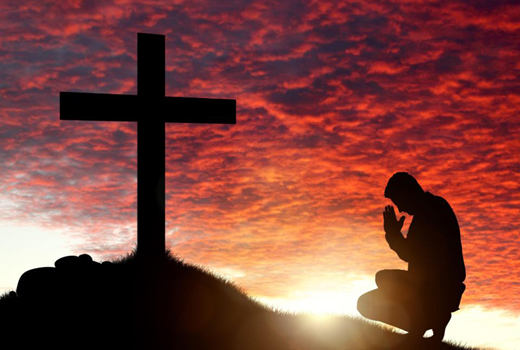
Christians to mark Lent from March 1: The 40 days of repentance
Mangalore Today News Network
Feb 28, 2017: "LENT" is that time of the year when Christians around the world abstain from things they would regularly indulge in. They fast, repent for their sins, and follow other ascetic practices during the 40-day period of Lent that begins on Ash Wednesday (1st March, this year). These 40 days commemorate Jesus Christ’s fast for 40 days and nights in the desert, before he began his public ministry.

Christians.Before Lent, however, comes the carnival, most popular in Goa. Derived from the Latin word carnem levare, meaning ‘to take away the flesh’, the carnival is the final festivity before Lent. Synonymous with costumes, floats and parades, “It came to Goa with the Portuguese, who ruled Goa for around 500 years,” says Francis Vaz, an event manager from Goa. The carnival parade goes down the streets of Panaji, Margao, Vasco and Mapusa, over four days.
Originating in the Middle Ages, Shrove Tuesday or Pancake Tuesday is celebrated on the Tuesday before Ash Wednesday. “Shrove Tuesday is derived from the word ‘shrive’, which means to confess and receive absolution,” explains Fr Reuben Tellis from Mount Carmel’s Church, Mumbai. “Ironically, Shrove Tuesday is regarded as the last day of feasting before the period of fasting, and has evolved into a day of frivolity and indulgence,” he says. ating pancakes, an English tradition, was a way to use as much milk, fats and eggs as possible. ‘Fat Tuesday’ or Mardi Gras was the French way of consuming fatty foods.
Initially, there were strict Lenten restrictions on the consumption of meats, eggs, milk and fish during Lent, which meant that these items would get spoilt during Lent. So, to prevent them from getting wasted, families would have big feasts on the Tuesday before Ash Wednesday.
Day of ashes : Marking the beginning of Lent, Ash Wednesday “comes from the ancient Jewish tradition of penance and fasting,” says Fr Reuben. The ashes, which symbolise the dust from which God made man (as per Christian belief), is applied during mass to each person’s forehead by the priest as he says, ‘Remember thou art dust, and to dust you shall return’ or ‘Repent and believe in the Gospel’. The marking of foreheads with ashes is meant to humble hearts and is a reminder that life on Earth is temporary. The ashes are made from blessed palm branches, taken from the previous year’s Palm Sunday Mass. Wearing of ashes was also seen as a sign of penance. A day of penitential prayer, abstinence and fasting, small children, the sick, elderly and pregnant women are exempt from fasting.
40-day atonement : While Lent lasts for 40 days, there are 46 days between Ash Wednesday and Easter. As Christ’s resurrection took place on Sunday, the Sabbath (the day of rest and worship) was transferred from Saturday (as per Jewish tradition) to Sunday. “Sundays were days to celebrate Christ’s Resurrection, and so Christians were forbidden from fasting and doing other forms of penance on Sundays,” explains Fr Reuben.
The Indian Orthodox Church, however, observes Lent not from Ash Wednesday as the Roman Catholics and Protestants do, but from a few days earlier (26th February, this year) and have a 50-day Lenten period. Great Lent concludes on the Friday before Holy Week with the Eucharist, but fasting continues throughout the Holy Week.
While prayer, fasting, abstinence and repentance is common across the different Churches, the prayers and rituals might differ. Missions (special preaching) and the Stations of the Cross are normally held in Roman Catholic churches. “We do not have the liturgy during Lent except on Saturdays and Sundays, because the joy of the Eucharist is contrary to the attitude of repentance—the theme of Lent. The Holy Week (Palm Sunday to Easter Sunday) is not included in the 40 days of Great Lent,” shares Deacon Aashu Alexander, Diocese of Mumbai, Indian Orthodox Church. “In the middle of Lent, a cross is placed in the centre of the church to remind parishioners that it is through the cross that humankind will be saved. The cross represents the bronze serpent, placed in the middle of the Israelite camp by Moses, as a symbol of hope and salvation,” he shares.
Holy week : Christians commemorate and remember the last week of Christ’s life on earth during Holy Week, which focuses on the suffering and resurrection of Christ and the events that led up to it. It begins with Palm/Passion Sunday, which as Fr Savarimuthu Sankar, spokesperson for the Archdiocese of Delhi explains is “the celebration of Christ’s triumphant entry into Jerusalem before he was arrested. In scripture, people placed palm branches on the road as Jesus rode into Jerusalem. On Palm Sunday, palms are blessed and distributed to the congregation, who go in procession to the church, where the story of Jesus’ arrest and death is traditionally read,” he says.
In the Indian Orthodox Church, after the Palm Sunday service, “before we enter Holy Week, the decorations in the church are changed to black, the colour of repentance, as a symbol of the passion of Christ,” says Deacon Aashu.
The Easter Triduum, is a three-part celebration on the three days (Maundy Thursday, Good Friday and Holy Saturday) just before Easter, “beginning with the Mass of the Lord’s Supper on Maundy Thursday, continuing with the celebration of the Lord’s Passion on Good Friday, and concluding with the Easter Vigil on Holy Saturday,” says Fr Savarimuthu. Easter Sunday is the celebration of Christ’s resurrection from the dead, which marks the triumph of good over evil, sin and death.